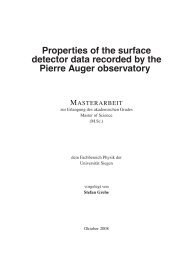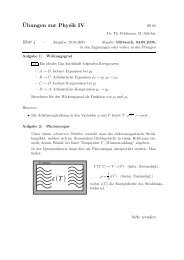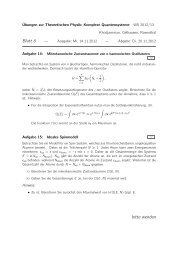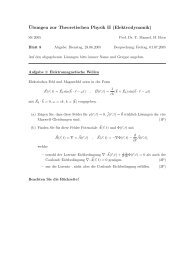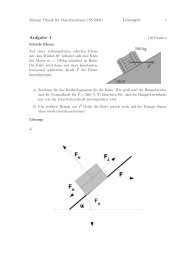Feynman Diagrams For Pedestrians - Herbstschule Maria Laach
Feynman Diagrams For Pedestrians - Herbstschule Maria Laach
Feynman Diagrams For Pedestrians - Herbstschule Maria Laach
You also want an ePaper? Increase the reach of your titles
YUMPU automatically turns print PDFs into web optimized ePapers that Google loves.
• NB: retardation is built in in (86), because we integrate over the four dimensionalspace time and not over the three dimensional space at a given instant.Problem 11. Show thatS(x, m) = (i/∂ + m) D(x, m) (88)is the <strong>Feynman</strong> propagator S for Dirac particles of mass m, i. e. that(i/∂ − m) S(x, m) = δ 4 (x)if (∂ 2 + m 2 )D(x, m) = −δ 4 (x), as in (85) above.• but what is the source ??? of the Dirac field????(y)S(x − y, m)ψ(x)(89)• consider the Dirac equation with (electromagnetic) interaction(i/∂ − e /A(x) − m) ψ(x) = 0 (90)or(i/∂ − m) ψ(x) = e /A(x)ψ(x) (90 ′ )• with the formal solutionψ(x) = ψ (0) (x) +∫d 4 yS(x − y, m)e /A(y)ψ(y) (91)that can be represented graphically asS(x − y, m)ψ(x)(91 ′ )• (91) is analogous to (86), when we use the current j µ (y) = −e ¯ψ(y)γ µ ψ(y)∫A µ (x) = A (0)µ (x) − d 4 yD(x − y, 0)e ¯ψ(y)γ µ ψ(y) (92)which can be represented graphically asD(x − y, 0)A µ (x)(92 ′ )• caveat: the equations (91) and (92) are not explicit solutions, but coupled integralequations16



